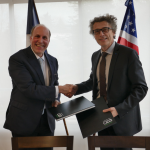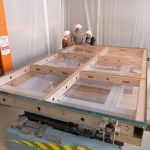For the first time, scientists have demonstrated that low-energy neutrinos can be thoroughly identified with a liquid-argon particle detector. The results, obtained with the ArgoNeuT experiment, are promising for experiments that use liquid argon to catch neutrinos, including the upcoming Deep Underground Neutrino Experiment.
neutrino
From Live Science, Dec. 25, 2018: Results from Fermilab’s MiniBooNE neutrino experiment makes Live Science’s top science stories of 2018, at number 4.
From Live Science, Jan. 1, 2019: One of the four is MiniBooNE’s search for a fourth neutrino, which could be a dark matter candidate.
From Syracuse University, Dec. 20, 2018: Collaborators at Syracuse University are contributing components for Fermilab’s Short-Baseline Near Detector, one of three particle detectors in the Short-Baseline Neutrino program.
Agencies in the United States and France have signed statements expressing interest to work together on the development and production of technical components for PIP-II, a major particle accelerator project with substantial international contributions. In addition, the French agencies also plan to collaborate on DUNE, an international flagship science project that will unlock the mysteries of neutrinos.
The upcoming Short-Baseline Near Detector at Fermilab continues scientists’ search for evidence of a hypothetical particle, the sterile neutrino. Collaborators around the world are participating in the detector’s construction. Its first critical components recently arrived from partner institutions. When complete, SBND will be the third and final detector in Fermilab’s Short-Baseline Neutrino Program.
From Forbes, Dec. 5, 2018: If there’s a fourth neutrino out there, Fermilab’s Short-Baseline Neutrino Program experiments will lead the way.
From Québec Science, Dec. 3, 2018: La mise en service d’immenses détecteurs au Fermilab, aux États-Unis, pourrait prochainement faire la lumière sur des particules aussi bizarres que prometteuses: les neutrinos.
From This Week in Science, Nov. 28, 2018: Fermilab scientist Alex Himmel talks about neutrinos, DUNE and the excitement of particle physics. Segment starts at 5:01.
From New Scientist, Nov. 21, 2018: Elusive though it is, the sterile neutrino would be a real boon. It could make sense of experimental anomalies stretching back decades, and give us the first confirmed glimpse of physics beyond what we know. Subscription required.



